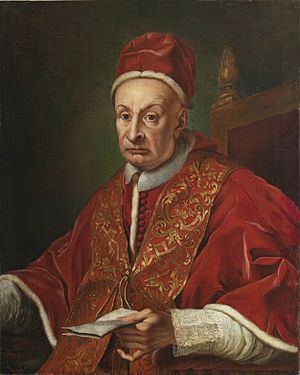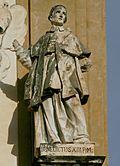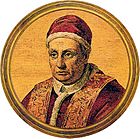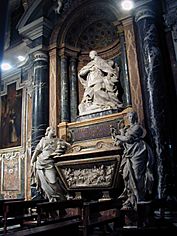Pope Benedict XIII facts for kids
Quick facts for kids Pope Servant of God Benedict XIII |
|
|---|---|
| Bishop of Rome | |

Portrait by Giuseppe Bazzani, c. 1725
|
|
| Church | Catholic Church |
| Papacy began | 29 May 1724 |
| Papacy ended | 21 February 1730 |
| Predecessor | Innocent XIII |
| Successor | Clement XII |
| Orders | |
| Ordination | 24 February 1671 |
| Consecration | 3 February 1675 by Paluzzo Paluzzi Altieri Degli Albertoni |
| Created Cardinal | 22 February 1672 |
| Personal details | |
| Birth name | Pietro Francesco Orsini |
| Born | 2 February 1649 Gravina in Puglia, Kingdom of Naples |
| Died | 21 February 1730 (aged 81) Rome, Lazio, Papal States |
| Previous post |
|
| Coat of arms | |
| Sainthood | |
| Venerated in | Catholic Church |
| Title as Saint | Servant of God |
| Other Popes named Benedict | |
Pope Benedict XIII (born Pietro Francesco Orsini, later known as Vincenzo Maria Orsini) was the leader of the Catholic Church and the ruler of the Papal States. He served from May 29, 1724, until his death in February 1730. His birth name was Pietro Francesco Orsini.
As a monk from the Dominican Order, Orsini cared more about his religious duties as a bishop. He was less interested in the daily running of the Pope's government. Because he wasn't very experienced in politics, he started to rely on a helper named Cardinal Niccolò Coscia. This helper was not honest with money. His actions caused problems with the Church's finances in Rome.
A process to make him a saint began in 1755 but stopped soon after. It was restarted in 1931, then closed again in 1940. The process opened once more in 2004. The official steps began in 2012 and finished in 2017. He now has the special title of Servant of God.
Contents
Early Life and Becoming a Monk
Pietro Francesco Orsini was born in Gravina in Puglia. He was the oldest of six sons. His father was Ferdinando III Orsini, the duke of Gravina. His mother was Giovanna Frangipani della Tolfa. He was part of the important Orsini family from Rome. He was the third and last person from this family to become a Pope.
When he was eighteen, he gave up his right to inherit his family's wealth. Instead, he joined the Dominican Order and took the name "Vincenzo Maria." He became a priest in February 1671.
Early Church Roles
Because of his family's influence, Pope Clement X named him a Cardinal-Priest. This happened on February 22, 1672. He was given the church of San Sisto Vecchio. It is said he did not want this role. He also taught philosophy in Brescia.
Later, he became a bishop of Manfredonia and then a bishop of Cesena. After that, he became the archbishop of Benevento. When earthquakes hit in 1688 and 1702, he helped organize aid for the people affected. He remained good friends with a local holy woman, Serafina of God.
Becoming Pope Benedict XIII
When Pope Innocent XIII died in 1724, a special meeting was held. This meeting, called a conclave, was to choose the next Pope. The cardinals were divided into four groups. There was no clear person everyone agreed on.
During the meeting, Orsini was seen as one of the possible choices for Pope. He was suggested because he lived a simple and strict life. People thought he would be a good spiritual leader. His lack of political experience also made him seem like a neutral choice.
Orsini did not want to be elected at first. He felt he was not worthy of the role. But he was eventually convinced to accept by Agustín Pipia. Pipia was the head of the Dominican Order. On May 29, 1724, Orsini was elected Pope. He chose the name "Benedict XIII." He picked this name to honor Pope Benedict XI, who was also a Dominican monk.
On June 4, 1724, he was crowned by Benedetto Pamphili. A few months later, on September 24, he officially took over the Basilica of St. John Lateran.
Pope Benedict XIII's Time as Pope
| Papal styles of Pope Benedict XIII |
|
|---|---|
 |
|
| Reference style | His Holiness |
| Spoken style | Your Holiness |
| Religious style | Holy Father |
| Posthumous style | Servant of God |
What He Did as Pope
Benedict XIII was not interested in worldly things. He tried to keep his simple monk's lifestyle. He worked to stop the fancy ways of life among the priests and cardinals in Italy. He also stopped the lottery in Rome and the Papal States. This lottery only helped other nearby states make money. He loved simple living and religious events. He built several hospitals. However, one cardinal said he "did not have any idea about how to rule."
In 1727, he opened the famous Spanish Steps in Rome. He also started the University of Camerino.
In 1728, Pope Benedict XIII helped solve a disagreement. This was about the holy items of Augustine of Hippo in Pavia. He confirmed that Augustine's bones, found in 1695, were real.
The actual running of the Papal States was mostly done by Cardinal Niccolò Coscia. Coscia had been the Pope's helper when he was an archbishop. Cardinal Coscia used his power to gain money for himself. This caused big problems for the Church's money. Coscia and his friends kept Pope Benedict XIII away from other advisors. Some people said that all the money from Rome was going to Coscia's hometown.
In dealings with other countries, he had difficulties with John V of Portugal. He also faced issues with a group called the Jansenists in France.
Recognizing New Saints
Pope Benedict XIII officially recognized several people as "Blessed" (beatified them):
- Bernardine of Feltre in 1728
- Peter Fourier in 1730
- Hyacintha of Mariscotti in 1726
- Fidelis of Sigmaringen in 1729
- Vincent de Paul in 1729
- Juan de Prado in 1728
He also declared many people "Saints" (canonized them):
- Pope Gregory VII in 1728
- Agnes of Montepulciano in 1726
- Aloysius Gonzaga and Stanislaus Kostka in 1726
- Brothers Boris and Gleb of Kiev in 1724
- Francis Solano in 1726
- James of the Marches and Turibius of Mogrovejo in 1726
- John of Nepomuk in 1729
- John of the Cross and Peregrine Laziosi in 1726
- Margaret of Cortona in 1728
- Serapion of Algiers in 1728
Naming a Doctor of the Church
The Pope gave Peter Chrysologus the special title of Doctor of the Church on February 19, 1729. This title is given to saints who have made important contributions to theology or doctrine.
Other Important Work
Pope Benedict XIII appointed 29 new cardinals during his time as Pope. These appointments happened in 12 different meetings. One of these new cardinals was Prospero Lambertini. He later became Pope Benedict XIV.
Benedict XIII personally helped make 139 bishops for important churches in Europe. These included bishops from Germany, France, England, and the New World. These bishops then went on to make other bishops in their own countries. Because of this, more than 90% of today's bishops can trace their spiritual family tree back to him.
With a special document called Pretiosus, dated May 26, 1727, Benedict XIII gave a right to all Dominican study houses. This right allowed them to give out academic degrees in theology. This was especially true for the Roman College of St. Thomas. This college later became the Pontifical University of Saint Thomas Aquinas.
Death and Burial
Benedict XIII suddenly became ill with a cold. He caught it while leading the funeral service for Cardinal Marco Antonio Ansidei. He died from this illness on February 21, 1730, at 81 years old. His death was announced to the public the next day.
The Pope was of average height. He had a kind face, a hooked nose, and a wide forehead. During his autopsy, doctors found that his heart was very large. His funeral was held at the Vatican. Later, his body was moved to the Santa Maria sopra Minerva church. He was buried there in a tomb finished by Pietro Bracci and others.
After the next Pope, Pope Clement XII, was chosen, Clement quickly punished Benedict XIII's dishonest helper, Cardinal Coscia. Coscia ran away from Rome to avoid punishment. However, he was later allowed to return. He even took part in the meetings to choose new Popes in 1730 and 1740.
Pope Benedict XIV later spoke kindly of Benedict XIII. He said, "We respectfully love that pontiff who backed his carriage rather than dispute the passage with a cartman." This happened when Benedict XIII told his driver, "Don't get us into a fight." On the other hand, someone wrote a funny, critical comment about Benedict XIII's death. It was posted at the Pasquino statue:
- This tomb encloses
- the bones of a little friar:
- more than a saint's lover
- a protector of brigands
Working Towards Sainthood
| Servant of God Benedict XIII |
|
|---|---|

Oil on canvas by an unknown 18th-century painter
|
|
| Pope; Confessor | |
| Born | Pietro Francesco Orsini 2 February 1649 Gravina in Puglia, Kingdom of Naples |
| Died | 21 February 1730 (aged 81) Apostolic Palace, Rome, Papal States |
| Venerated in | Roman Catholic Church |
| Attributes | Papal attire Papal tiara Dominican habit |
| Patronage | Gravina in Puglia Archdiocese of Benevento |

The process to make him a saint began in Tortona in 1755. This was under Pope Benedict XIV. But it did not move forward and was stopped. On February 21, 1931, the process was started again in Tortona. However, there were questions about the honesty of the late Pope's chief helper, Niccolò Coscia. This caused the process to close again in 1940.
The process was reopened on January 17, 2004. The official steps in Rome began in early 2012. The start of this process was held at the Basilica of Saint John Lateran. It was led by Agostino Vallini. The local part of the sainthood process finished on February 24, 2017. This was also at the Basilica of Saint John Lateran, with Vallini celebrating the end of the investigation. He now has the special title of Servant of God.
The person currently in charge of this process is a Dominican priest named Francesco Maria Ricci.
 In Spanish: Benedicto XIII (papa) para niños
In Spanish: Benedicto XIII (papa) para niños
See also
- Orsini family
- Cardinals created by Benedict XIII
- List of popes





